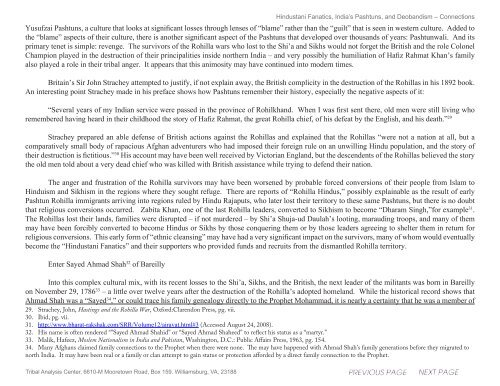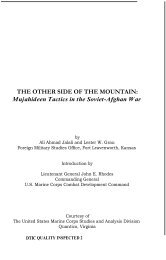Hindustani Fanatics, India’s Pashtuns, <strong>and</strong> Deob<strong>and</strong>ism – ConnectionsHafiz Rahmat Khan assembled his Sardars, or chiefs, in an effort to raise the large sum of money dem<strong>and</strong>ed by Shuja-ud Daulah, but none ofthe chiefs were willing to contribute money <strong>and</strong> the Rohilla chief was forced to prepare for a war he didn’t want to fight. As troops began to moveShuja increased his dem<strong>and</strong> for additional money to avoid the war as Hafiz Rahmat Khan attempted to get the British comm<strong>and</strong>er in the region,Colonel Champion, to mediate. Shuja-ud Daulah knew the advantage was on his side. He had been allied with the British before <strong>and</strong> knew they wouldtilt toward him as the conflict approached.In the end, the two very mismatched forces engaged one another on April 23, 1774 <strong>and</strong> while the smaller Rohilla force fought gallantly theoutcome was preordained. A British officer present during the battle wrote of the Rohillas:“… gave proof of a good share of military knowledge by showing inclination to face both our flanks at the same time, <strong>and</strong> endeavoring to callour attention by brisk fire on our centre…. It is impossible to describe a more obstinate firmness of resolution than the enemy displayed; numerouswere their gallant men who advanced <strong>and</strong> often pitched their colours between both armies in order to encourage their men to follow them.” 25The British army was experiencing their first encounter with men they would later know as “Hindustanic Fanatics,” men who fought bravelyagainst great odds in a manner that impressed at least one English officer. The battle ended quickly after a shot from a cannon struck Hafiz RahmatKhan in the chest, killing him instantly. His two sons, comm<strong>and</strong>ers in the center of the Rohilla line, also lost their lives as the Rohilla survivors soonfled the battlefield for prepared sanctuaries, but they left 2,000 bodies of their men behind. Soon, they would have even more reasons to hate theBritish enough to continue their efforts against the British colonial authorities for several additional generations.As the Rohilla army left the field the victors in the battle began to set deep, <strong>and</strong> lasting, hatred into motion. The victorious allies, ShujaudDaulah <strong>and</strong> Colonel Champion, remained on the battlefield for an additional three days as small detachments of their troops were sent into thecountryside where they embarked on what Iqbal Husain described as a “reign of terror” 26 . More than a thous<strong>and</strong> villages were burned <strong>and</strong> thous<strong>and</strong>sof various structures were destroyed in what must have appeared to be an attempt at “ethnic cleansing” by Shi’a Shuja-ud Daulah’s men, in spite ofColonel Champion’s protests. 27But the Rohillas learned little from their recent defeat <strong>and</strong> instead of regrouping under a single leader, they fragmented further with someof them, including some of Hafiz Rahmat Khan’s sons, seeking to accommodate with Shuja-ud Daulah. Their principle city, Bareilly, fell withoutresistance. Leaders of some of the Rohilla tribes remained neutral, but they were quickly attacked <strong>and</strong> their possessions looted. According to IqbalHusain, nearly 20,000 Rohillas sought refuge at Agra, but by the end of the campaign the Rohilla Confederacy had been destroyed 28 . Adding to theinstability, Sikh raiders attacked the weakened Rohillas. In the end, Shuja-ud Daulah overcame his enemies, gained territory with rich agriculturall<strong>and</strong>, enhanced his treasury with loot confiscated from Rohilla families, <strong>and</strong> the British, the Shi’as, <strong>and</strong> the Sikhs got the blame from the Rohillas whoseem to have never forgotten that Colonel Champion allied himself with Shuja-ud Daulah instead of Hafiz Rahmat Khan. Rohillas were primarily25. Husain, pp. 131. Iqbal Husain presents an excellent account of the politics surrounding the final battle between the British <strong>and</strong> Shuja-ud Daulah against the Rohillasbeginning on page 131.26. Husain, pg. 168.27. Husain, pg. 170. His text mentions that the treatment of Hafiz Rahmat Khan’s family was “one of studied harshness <strong>and</strong> designed to inflict humiliation.28. Husain, pg. 172.Tribal Analysis Center, 6610-M Mooretown Road, Box 159. Williamsburg, VA, 23188
Hindustani Fanatics, India’s Pashtuns, <strong>and</strong> Deob<strong>and</strong>ism – ConnectionsYusufzai Pashtuns, a culture that looks at significant losses through lenses of “blame” rather than the “guilt” that is seen in western culture. Added tothe “blame” aspects of their culture, there is another significant aspect of the Pashtuns that developed over thous<strong>and</strong>s of years: Pashtunwali. And itsprimary tenet is simple: revenge. The survivors of the Rohilla wars who lost to the Shi’a <strong>and</strong> Sikhs would not forget the British <strong>and</strong> the role ColonelChampion played in the destruction of their principalities inside northern India – <strong>and</strong> very possibly the humiliation of Hafiz Rahmat Khan’s familyalso played a role in their tribal anger. It appears that this animosity may have continued into modern times.Britain’s Sir John Strachey attempted to justify, if not explain away, the British complicity in the destruction of the Rohillas in his 1892 book.An interesting point Strachey made in his preface shows how Pashtuns remember their history, especially the negative aspects of it:“Several years of my Indian service were passed in the province of Rohilkh<strong>and</strong>. When I was first sent there, old men were still living whoremembered having heard in their childhood the story of Hafiz Rahmat, the great Rohilla chief, of his defeat by the English, <strong>and</strong> his death.” 29Strachey prepared an able defense of British actions against the Rohillas <strong>and</strong> explained that the Rohillas “were not a nation at all, but acomparatively small body of rapacious Afghan adventurers who had imposed their foreign rule on an unwilling Hindu population, <strong>and</strong> the story oftheir destruction is fictitious.” 30 His account may have been well received by Victorian Engl<strong>and</strong>, but the descendents of the Rohillas believed the storythe old men told about a very dead chief who was killed with British assistance while trying to defend their nation.The anger <strong>and</strong> frustration of the Rohilla survivors may have been worsened by probable forced conversions of their people from Islam toHinduism <strong>and</strong> Sikhism in the regions where they sought refuge. There are reports of “Rohilla Hindus,” possibly explainable as the result of earlyPashtun Rohilla immigrants arriving into regions ruled by Hindu Rajaputs, who later lost their territory to these same Pashtuns, but there is no doubtthat religious conversions occurred. Zabita Khan, one of the last Rohilla leaders, converted to Sikhism to become “Dharam Singh,”for example 31 .The Rohillas lost their l<strong>and</strong>s, families were disrupted – if not murdered – by Shi’a Shuja-ud Daulah’s looting, marauding troops, <strong>and</strong> many of themmay have been forcibly converted to become Hindus or Sikhs by those conquering them or by those leaders agreeing to shelter them in return forreligious conversions. This early form of “ethnic cleansing” may have had a very significant impact on the survivors, many of whom would eventuallybecome the “Hindustani Fanatics” <strong>and</strong> their supporters who provided funds <strong>and</strong> recruits from the dismantled Rohilla territory.Enter Sayed Ahmad Shah 32 of BareillyInto this complex cultural mix, with its recent losses to the Shi’a, Sikhs, <strong>and</strong> the British, the next leader of the militants was born in Bareillyon November 29, 1786 33 – a little over twelve years after the destruction of the Rohilla’s adopted homel<strong>and</strong>. While the historical record shows thatAhmad Shah was a “Sayed 34 ,” or could trace his family genealogy directly to the Prophet Mohammad, it is nearly a certainty that he was a member of29. Strachey, John, Hastings <strong>and</strong> the Rohilla War, Oxford:Clarendon Press, pg. vii.30. Ibid, pg. vii.31. http://www.bharat-rakshak.com/SRR/Volume12/airavat.html#3 (Accessed August 24, 2008).32. His name is often rendered “”Sayed Ahmad Shahid” or “Sayed Ahmad Shaheed” to reflect his status as a “martyr.”33. Malik, Hafeez, Moslem Nationalism in India <strong>and</strong> Pakistan, Washington, D.C.: Public Affairs Press, 1963, pg. 154.34. Many Afghans claimed family <strong>connections</strong> to the Prophet when there were none. The may have happened with Ahmad Shah’s family generations before they migrated tonorth India. It may have been real or a family or clan attempt to gain status or protection afforded by a direct family connection to the Prophet.Tribal Analysis Center, 6610-M Mooretown Road, Box 159. Williamsburg, VA, 23188
- Page 7 and 8: Hindustani Fanatics, India’s Pash
- Page 9: Hindustani Fanatics, India’s Pash
- Page 13 and 14: Hindustani Fanatics, India’s Pash
- Page 15 and 16: And Charles Allen described the sce
- Page 17 and 18: Hindustani Fanatics, India’s Pash
- Page 19 and 20: Charles Allen provided additional d
- Page 21 and 22: Hindustani Fanatics, India’s Pash
- Page 23 and 24: Hindustani Fanatics, India’s Pash
- Page 25 and 26: Hindustani Fanatics, India’s Pash
- Page 27 and 28: Hindustani Fanatics, India’s Pash
- Page 29 and 30: that Shah Waliullah’s ancestors w
- Page 32: Hindustani Fanatics, India’s Pash
- Page 35 and 36: Hindustani Fanatics, India’s Pash
- Page 37 and 38: Hindustani Fanatics, India’s Pash
- Page 39: Hindustani Fanatics, India’s Pash
- Page 42 and 43: Hindustani Fanatics, India’s Pash
- Page 44 and 45: Hindustani Fanatics, India’s Pash
- Page 46 and 47: Hindustani Fanatics, India’s Pash
- Page 48 and 49: Hindustani Fanatics, India’s Pash
- Page 50 and 51: Hindustani Fanatics, India’s Pash
- Page 52 and 53: Hindustani Fanatics, India’s Pash
- Page 54 and 55: Hindustani Fanatics, India’s Pash
















